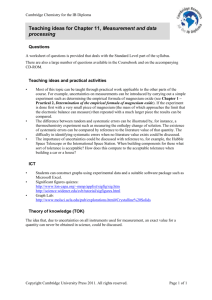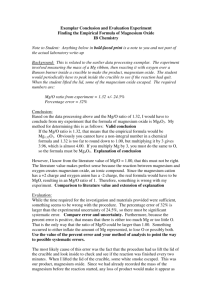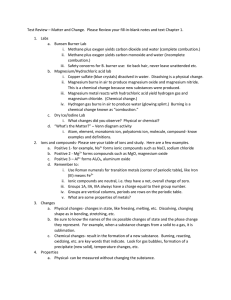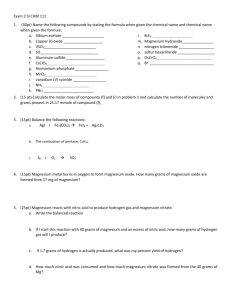1. Copper is an element because _____________________________________________________________ ______________________________________________________________________________________
advertisement
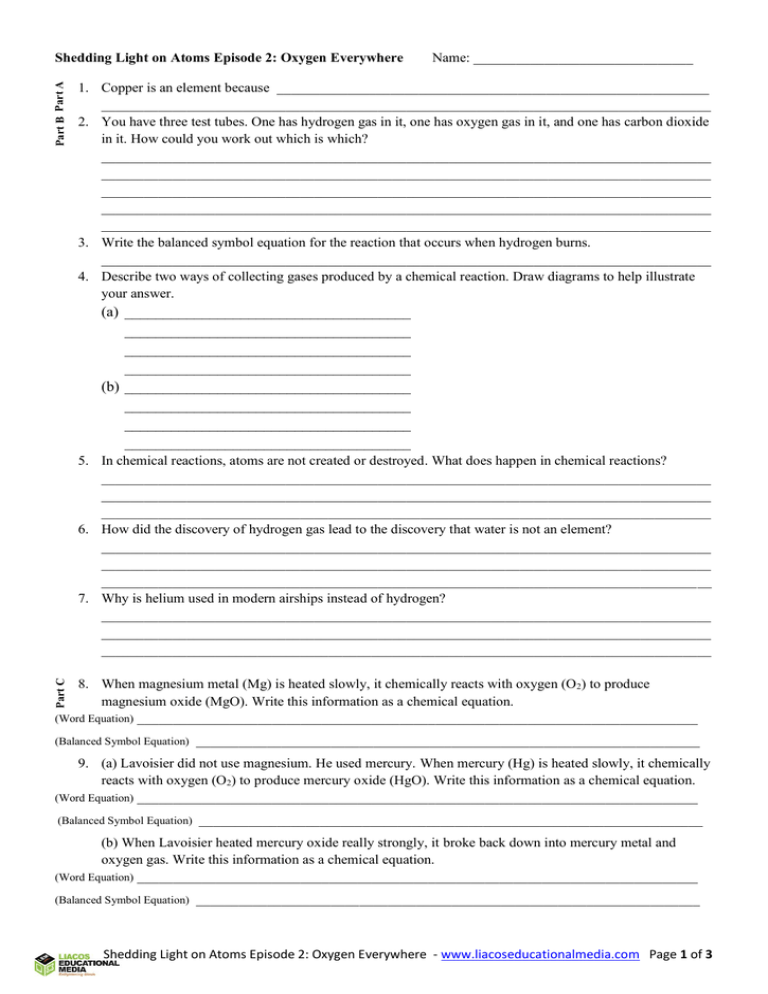
Part B Part A Shedding Light on Atoms Episode 2: Oxygen Everywhere Name: _______________________________ 1. Copper is an element because _____________________________________________________________ ______________________________________________________________________________________ 2. You have three test tubes. One has hydrogen gas in it, one has oxygen gas in it, and one has carbon dioxide in it. How could you work out which is which? ______________________________________________________________________________________ ______________________________________________________________________________________ ______________________________________________________________________________________ ______________________________________________________________________________________ ______________________________________________________________________________________ 3. Write the balanced symbol equation for the reaction that occurs when hydrogen burns. ______________________________________________________________________________________ 4. Describe two ways of collecting gases produced by a chemical reaction. Draw diagrams to help illustrate your answer. (a) _____________________________________ _____________________________________ _____________________________________ _____________________________________ (b) _____________________________________ _____________________________________ _____________________________________ _____________________________________ Part C 5. In chemical reactions, atoms are not created or destroyed. What does happen in chemical reactions? ______________________________________________________________________________________ ______________________________________________________________________________________ ______________________________________________________________________________________ 6. How did the discovery of hydrogen gas lead to the discovery that water is not an element? ______________________________________________________________________________________ ______________________________________________________________________________________ ______________________________________________________________________________________ 7. Why is helium used in modern airships instead of hydrogen? ______________________________________________________________________________________ ______________________________________________________________________________________ ______________________________________________________________________________________ 8. When magnesium metal (Mg) is heated slowly, it chemically reacts with oxygen (O 2) to produce magnesium oxide (MgO). Write this information as a chemical equation. (Word Equation) _______________________________________________________________________________ (Balanced Symbol Equation) _______________________________________________________________________ 9. (a) Lavoisier did not use magnesium. He used mercury. When mercury (Hg) is heated slowly, it chemically reacts with oxygen (O2) to produce mercury oxide (HgO). Write this information as a chemical equation. (Word Equation) _______________________________________________________________________________ (Balanced Symbol Equation) _______________________________________________________________________ (b) When Lavoisier heated mercury oxide really strongly, it broke back down into mercury metal and oxygen gas. Write this information as a chemical equation. (Word Equation) _______________________________________________________________________________ (Balanced Symbol Equation) _______________________________________________________________________ Shedding Light on Atoms Episode 2: Oxygen Everywhere - www.liacoseducationalmedia.com Page 1 of 3 10. If you slowly heat a fixed amount of magnesium, the magnesium oxide powder that is formed is heavier than the original amount of magnesium. Why? ______________________________________________________________________________________ ______________________________________________________________________________________ ______________________________________________________________________________________ 11. Data-Analysis Exercise: A student heats up exactly 0.200 grams of magnesium in a crucible, and it eventually turns into magnesium oxide, a white powder. The student keeps the lid on the crucible for most of the experiment to ensure that no smoke escapes. Below are the results that were obtained. (a) Fill in the missing values. Mass of magnesium strip: 0.200grams Mass of crucible + lid: 23.800grams Mass of crucible + lid + magnesium strip: _______________ Mass of crucible + lid + magnesium oxide: 24.132grams Overall increase in mass: _______________ grams (which comes as a result of the oxygen that reacted with the magnesium) Mass of the magnesium oxide that formed: ________________ grams The chemical equation: ___________ grams magnesium + ___________ grams oxygen ___________ grams magnesium oxide (b) Why is it better to calculate the mass of the magnesium oxide that was produced rather than scraping out the magnesium oxide onto the electronic scales? ______________________________________________________________________________________ ______________________________________________________________________________________ 12. When Antoine Lavoisier heated his sample of mercury in an enclosed container (which had air in it), he noticed that about 80% of the air in the container did not chemically react with the mercury, but about 20% did. Explain this set of results. ______________________________________________________________________________________ ______________________________________________________________________________________ ______________________________________________________________________________________ ______________________________________________________________________________________ ______________________________________________________________________________________ 13. Fill in the tables below. Atmospheric Composition Gas Amount (%) % Composition of Inhaled and Exhaled Air Gas nitrogen (N2) oxygen (O2) argon (Ar) carbon dioxide (CO2) other gases inhaled air (atmospheric air) exhaled air nitrogen (N2) oxygen (O2) carbon dioxide (CO2) other gases 14. What happens to the nitrogen (N2) we inhale? ______________________________________________________________________________________ ______________________________________________________________________________________ Shedding Light on Atoms Episode 2: Oxygen Everywhere - www.liacoseducationalmedia.com Page 2 of 3 Part D 15. What happens to the oxygen (O2) we inhale? ______________________________________________________________________________________ ______________________________________________________________________________________ ______________________________________________________________________________________ ______________________________________________________________________________________ 16. Where does the carbon dioxide (CO2) in the air we exhale come from? ______________________________________________________________________________________ ______________________________________________________________________________________ ______________________________________________________________________________________ 17. Place the following substances into the correct column. carbon (C), oxygen (O), carbon dioxide (CO2), sea water, hydrogen (H), water (H2O), nitrogen (N), wood, carbon monoxide (CO), bread, magnesium (Mg), concrete, magnesium oxide (MgO), Zinc (Zn), copper (Cu), salt (NaCl), the atmosphere. Elements Compounds Mixtures Skill-Building Exercises 18. Balance the following equations: (it’s usually best to just work in order; balance the Cs first, then the Hs and then the Os) (you don’t need to write a “1” if, for example, you need only 1 CH4) ____ CH4 + ____ O2 ____ CO2 + ____ H2O ____ C3H8 + ____ O2 ____ CO2 + ____ H2O ____ C5H12 + ____ O2 ____ CO2 + ____ H2O ____ C2H6 + ____ O2 ____ CO2 + ____ H2O (a slightly harder one) 19. Balance the following equations: ____ Na + ____ Cl2 ____ NaCl ____ P + ____ O2 ____ P4O10 ____ Fe + ____ O2 ____ FeO ____ NH3 + ____ O2 ____ N2 + ____ H2O ____ HCl + ____ CaO ____ CaCl2 + ____ H2O Shedding Light on Atoms Episode 2: Oxygen Everywhere - www.liacoseducationalmedia.com Page 3 of 3


